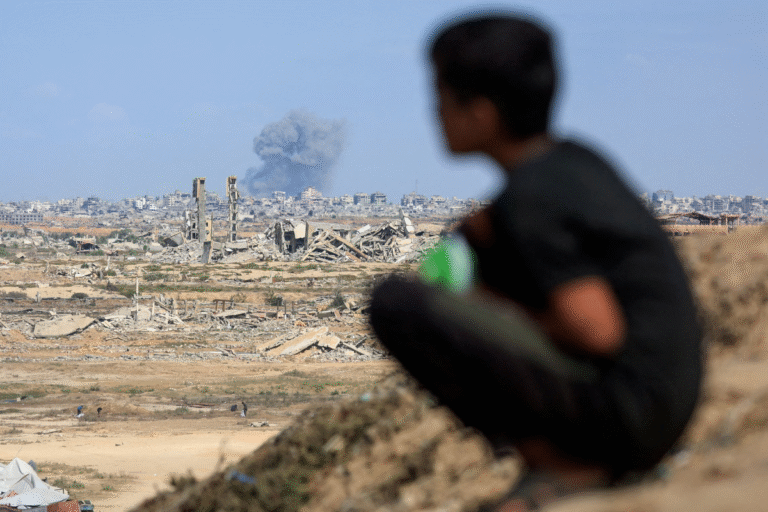Yet, as relief spreads across the region, analysts caution the deal’s success will hinge on how it is implemented and whether both sides can turn this fragile pause into a lasting peace.
The ceasefire deal, described as the first phase of a broader peace framework, includes the release of all remaining hostages held in Gaza, the withdrawal of Israeli troops to an agreed line, and the release of Palestinian prisoners. It also allows for the entry of humanitarian aid and the start of reconstruction efforts.
US President Donald Trump – who announced the agreement – said a “council of peace” would be established to maintain stability, while confirming plans to visit Israel and Egypt in the coming days. Israeli Prime Minister Benjamin Netanyahu hailed the development as “a great day for Israel”, and celebrations broke out across both Israel and Gaza overnight.
However, Israeli military operations have not yet fully ceased. The army has instructed its forces to “be ready for any scenario” and warned Palestinians not to return to areas where troops remain stationed.
‘Cautious optimism’ across the region
Mahdi Ghuloom, Junior Fellow in Geopolitics at ORF Middle East, said the timing of the agreement is significant.
“This deal is long overdue,” he told Arabian Business. “Its importance lies in averting what seemed to be a slide towards an even worse escalation. There’s reason to be cautiously optimistic – this is the start of the ‘day after’ phase many have been discussing.”
Ghuloom added that the next challenge will be ensuring that the ceasefire transitions into a sustained peace.
“The next phase will require not just the traditional mediators like Qatar and Egypt, but also partners such as the UAE,” he said. “The UAE’s role has been fundamental in facilitating aid to Gaza, and it will likely be central in ensuring the peace delivers tangible benefits for people on the ground.”
What the truce means for the wider region
According to Abishur Prakash, Geopolitical Strategist and Founder of The Geopolitical Business Inc., the agreement could open the door to a broader stabilisation of the Middle East.
“An opening is forming for stability to return to the region,” he said. “A pause in fighting in Gaza paves the way for a reintegration between the Arab world and Israel.”
But Prakash warned that while the guns may fall silent, the geopolitics will not.
“There remains a lot of greyness – including whether the Israel-Turkey situation can be resolved and what happens next between Israel and Iran, especially as sanctions are reimposed on Tehran,” he explained.
He also noted that Hamas has not been defeated militarily.
“Some figures show the group has roughly the same number of soldiers today as before 7 October,” he said. “This leaves the door wide open to renewed fighting.”
Regional dynamics shift
Dr Elie Al Hindy, Chairperson of the Department of Security and Strategic Studies at the American University in the Emirates, said the truce reflects a convergence of interests among the key players – each under mounting pressure to end the bloodshed.
“Finally, the players are coming to their senses and stopping the bombings that have gone on for years,” he said. “Hamas cannot justify the deaths caused by its actions, Netanyahu is facing enormous international pressure, and Trump is actively seeking his legacy moment – perhaps even a Nobel Peace Prize.”
According to Dr Al Hindy, the deal also signals a more unified Arab front.
“The unified Arab position – especially after the attack on Qatar – helped secure vital guarantees from Trump: no deportation of Palestinians from Gaza, no annexation of the West Bank, and no Hamas role in governing Palestinian territories in the future,” he said.
He believes these terms give the ceasefire a real chance of holding, though obstacles remain.
“There are still many tricky points ahead,” he cautioned. “Setbacks can be expected, but hopefully not a full collapse of the agreement.”
Will the truce last?
Prakash warned that the ceasefire’s durability depends on several volatile factors.
“This depends on whether another attack takes place against Israel, how the situation between Israel and Iran plays out, the level of normalisation between Arab powers and Israel, and the domestic politics within Israeli society,” he said.
He described the deal as both promising and precarious.
“At one level, the ceasefire is extremely fragile,” he noted. “On another level, the headache of returning to war – the economic toll and social resistance – could outweigh other voices.”
However, key details remain uncertain. Neither side has outlined how Gaza will be governed once Israeli forces withdraw, and the issue of Hamas’s disarmament remains unresolved.
Questions also persist over reconstruction. Trump has said regional states will help rebuild Gaza but offered no specifics. The UN has pledged to scale up humanitarian and recovery operations.
A turning point, not yet peace
Despite the uncertainty, both experts see the ceasefire as a turning point – a moment when regional diplomacy, long gridlocked, has begun to shift.
“The time of ideological warfare is over,” said Dr Al Hindy. “The future of the region will be set by those willing to negotiate and build peace. Wars based on scriptural interpretations have no place in the twenty-first century.”
Yet he warned that the events of 7 October 2023 – the Hamas-led attack that ignited the war – may have permanently altered the political landscape.
“The hope for a sovereign, independent Palestinian state within the 1967 borders may have been damaged irreparably,” he said. “Something new will need to be envisioned.”
For now, the ceasefire represents an opening – a pause in a cycle of violence that has claimed tens of thousands of lives and displaced millions. But as both sides prepare for the difficult implementation phase, the sense of relief is tempered by realism.
As Mahdi Ghuloom put it, “This is the first phase of the end of the war – not the end itself.”

